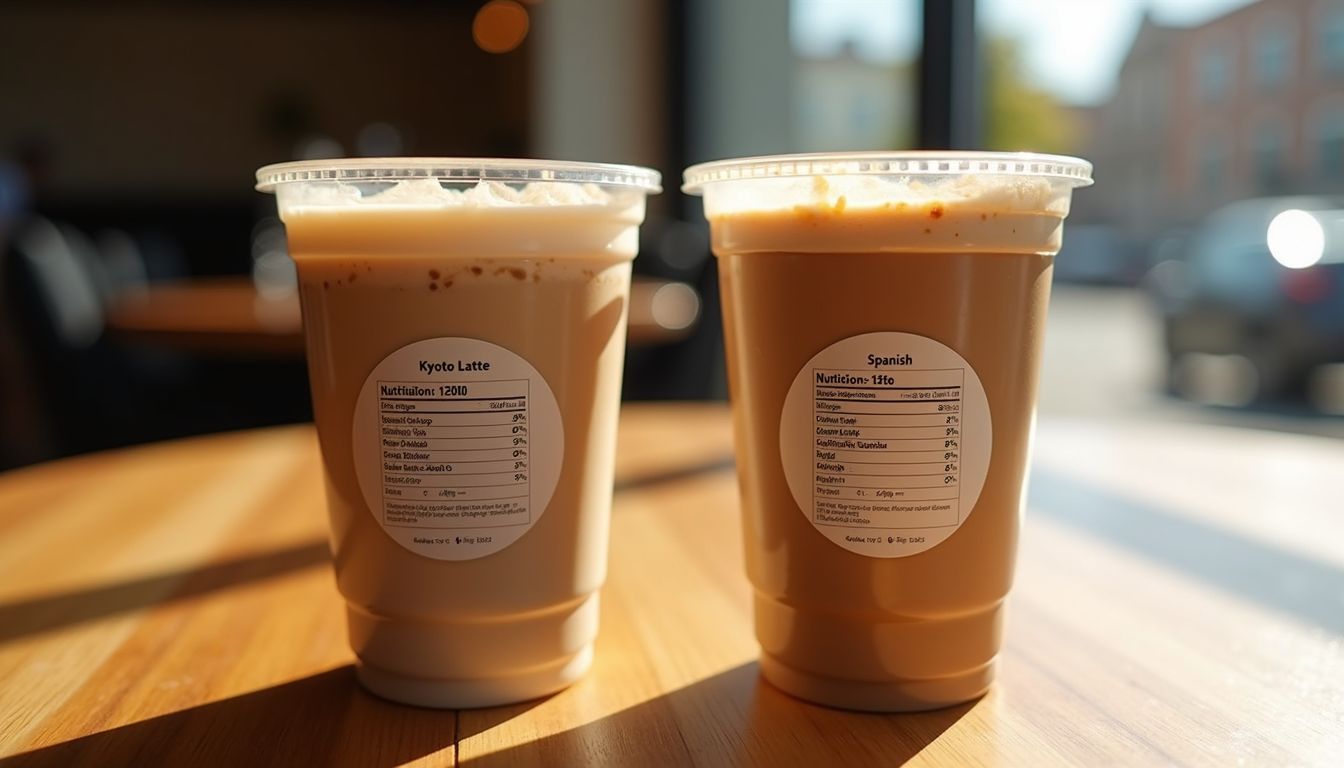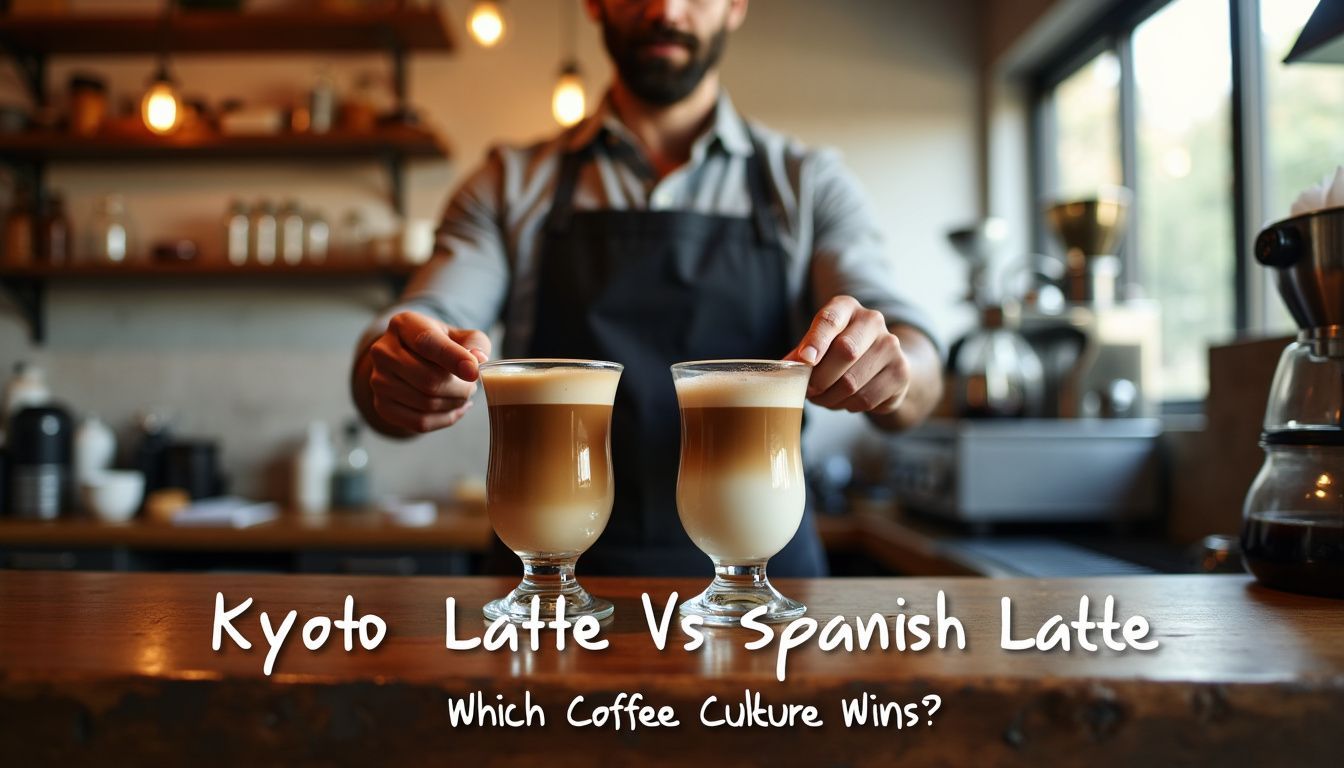Kyoto Latte Vs Spanish Latte: A Delicious Comparison Of Japanese And Spanish Coffee Culture
Kyoto Latte and Spanish Latte present unique experiences, each appealing to distinct taste preferences. Kyoto Latte blends espresso, textured milk, and a hint of condensed milk. This concoction, crafted by % Arabica, delivers delicate sweetness and stands apart from the Kyoto-style cold brew.
By contrast, the Spanish Latte, known as café con leche, combines espresso, steamed milk, and condensed milk in equal portions, creating a drink with pronounced chocolate and caramel flavours.
Exploring their origins reveals cultural richness, adding depth to each brew. For those eager to replicate these creations at home, consider using visuals like photos to identify key ingredients and achieve the desired consistency.
Understanding these elements deepens appreciation for both lattes and enriches your coffee repertoire.
What Sets Kyoto Latte and Spanish Latte Apart?
Kyoto Latte and Spanish Latte offer unique coffee experiences. Kyoto Latte blends rich espresso with textured milk and a touch of condensed milk. This mix creates a subtle sweetness and smooth taste.
Spanish Latte, known as café con leche, uses equal parts espresso, steamed milk, and sweetened condensed milk. It boasts bold flavours of chocolate and caramelised sugar.
These drinks reflect different coffee cultures. Kyoto Latte showcases Kyoto’s distinct coffee scene. Spanish Latte is a favourite in Spain and across Europe. Both use espresso as a base but differ in milk types and sweetness levels.
Your choice depends on whether you prefer a gentle or bold sweet coffee taste.
What Is A Kyoto Latte?

The Kyoto latte combines espresso with textured milk and a touch of condensed milk to create a smooth and sweet drink. This unique beverage, developed by the renowned % Arabica café, stands out with its subtle sweetness and rich flavour.
Unlike a traditional caffè latte, which relies on the natural sweetness of milk, the Kyoto latte adds condensed milk for a slight indulgence.
The exact amount of condensed milk is not widely known but likely does not exceed a tablespoon, offering just the right balance. It’s essential not to confuse the Kyoto latte with Kyoto style cold brew, which uses a slow drip coffee method, as the two beverages offer distinctly different flavour profiles.
This drink highlights Kyoto’s unique coffee culture and brings something fresh to the coffee scene worldwide.
You’ll find Kyoto Latte served in speciality coffee shops worldwide. The drink’s popularity has grown due to its refreshing qualities and the growing demand for artisanal coffee experiences.
What Is A Spanish Latte?
Spanish Latte is a rich, creamy coffee drink that originated in Spain. The Spanish Latte combines three essential ingredients: Espresso, Steamed Milk, and Sweetened Condensed Milk.
This drink, often enjoyed in Spain and across Europe, differs from traditional lattes by using condensed milk, which adds a rich sweetness. The Espresso delivers a bold coffee base, while the Steamed Milk provides a creamy texture, balancing the flavours.
The unique sweetness from the Condensed Milk creates a delightful contrast with the espresso, offering a smooth and indulgent experience. This layered beverage is both visually appealing and delicious, with a perfect balance of sweetness and bitterness.
You’ll find Spanish Lattes in cafés across Spain and beyond. The drink’s popularity has grown globally, appealing to those who enjoy their coffee with a touch of sweetness. Its distinctive taste comes from the condensed milk, which adds a velvety texture and caramel-like notes to the espresso base.
How to Make a Kyoto Latte
To make a Kyoto latte, begin by preparing it similarly to a traditional latte with one key difference: the addition of condensed milk. You will need an espresso machine with a milk steaming wand.
Kyoto Latte needs an espresso machine and skilled milk steaming. You’ll learn how to make this smooth drink at home.
Essentials of Brewing with an Espresso Machine
Brewing with an espresso machine requires skill and the right tools. Here are the key steps to make a perfect espresso:
- Use fresh, quality coffee beans. Grind them just before brewing for the best flavour.
- Fill the portafilter with ground coffee. Tamp it down firmly and evenly.
- Lock the portafilter into the machine. Start the extraction right away.
- Watch the espresso flow. It should look like honey and take about 25-30 seconds.
- Stop the shot when you have 30ml of espresso. The crema should be golden-brown.
- Clean the portafilter and group head after each use. This keeps your machine in top shape.
- Adjust grind size and dose as needed. This helps you get the perfect shot every time.
- Steam milk if making a latte. Use the wand to create a velvety texture.
- Pour the milk slowly into the espresso. Try your hand at latte art if you’re feeling fancy.
- Enjoy your drink right away. Espresso tastes best when fresh.
Perfecting Milk Steaming and Milk Ratios
Milk steaming and ratios are key to a great latte. Follow these tips for the perfect cup:
- Heat milk to 65°C for ideal taste and texture
- Use whole milk for a rich, creamy flavour
- Steam milk until it has a glossy sheen
- Aim for a milk-to-espresso ratio of 3:1
- Tilt the jug while steaming to create a whirlpool effect
- Tap the jug on the counter to break large bubbles
- Pour slowly to mix the milk and espresso evenly
- Add one tablespoon of condensed milk for extra sweetness
- Adjust condensed milk based on milk fat content
- Skip evaporated milk as it won’t create the right texture
How to Make a Spanish Latte
A Spanish Latte blends bold espresso with creamy milk and sweet condensed milk, creating a rich, velvety drink.
Sanish Latte brewing needs skill in mixing espresso and milk. Learn how to make this sweet, creamy drink at home.
Mastering Espresso and Milk Integration
Espresso and milk integration forms the heart of a Spanish latte. Here’s how to master this art:
- Pull a perfect espresso shot. Use freshly ground beans and extract 25-30 ml in 25-30 seconds.
- Steam milk to 65°C. Create a silky microfoam with tiny, uniform bubbles.
- Pour espresso into a warm cup. Add steamed milk slowly, tilting the cup to mix layers.
- Adjust milk-to-espresso ratio. Aim for 1:3 for a balanced flavour.
- Add sweetener if desired. Use condensed milk or syrup to taste.
- Stir gently to blend flavours. Don’t over mix to keep layers intact.
- Serve immediately. Enjoy the creamy texture and rich taste.
Sweeteners: Condensed Milk vs. Alternatives
Condensed milk adds a rich sweetness to Spanish lattes. It creates a creamy, indulgent taste that many coffee lovers enjoy. Natural sweeteners offer healthier options. Honey, agave syrup, or maple syrup can replace condensed milk.
These alternatives provide unique flavours without the added sugar.
You can mix in your chosen sweetener to suit your taste. A sprinkle of cinnamon or cocoa powder on top enhances the flavour. These toppings complement the bold notes of chocolate and caramel in the latte.
Your ideal Spanish latte balances sweetness with the strong coffee base.
Compare Taste and Texture: Kyoto Latte vs Spanish Latte

Kyoto and Spanish lattes offer distinct taste profiles and textures, catering to different coffee preferences. Here’s a comparison of these two popular beverages:
| Kyoto Latte | Spanish Latte | |
|---|---|---|
| Taste | Smooth, rich, pure coffee flavour | Balance of sweetness and strength |
| Texture | Velvety | Creamy |
| Sweetness | No added sweeteners | Sweetened with condensed milk |
| Coffee Intensity | Strong, pronounced coffee notes | Bold espresso flavour, tempered by sweetness |
| Aftertaste | Clean, lingering coffee finish | Sweet, milky finish |
You’ll notice Kyoto lattes offer a purer coffee experience. They highlight the bean’s natural flavours without added sweetness. The texture feels silky on your tongue, with a clean aftertaste.
Spanish lattes give you a sweeter sip. The condensed milk adds richness and balances the espresso’s boldness. You’ll enjoy a creamier mouthfeel and a sweet, milky finish.
Choose Kyoto lattes for a straightforward coffee flavour. Opt for Spanish lattes when you crave a sweeter, more indulgent drink. Both offer unique tastes that reflect their cultural origins.
Cultural Context and Preferences

Coffee tastes differ across cultures. Kyoto latte fans love pure flavours, while Spanish latte drinkers enjoy sweet, creamy drinks. Want to know which one suits you best? Read on to find out more about these unique coffee styles.
Why Coffee Purists Favour Kyoto Latte
Coffee purists love Kyoto Latte for its clean, pure taste. This drink shows off the natural flavours of coffee beans. You’ll taste a strong coffee note that lingers on your tongue.
Kyoto Latte uses special brewing methods to create a smooth, rich flavour.
Kyoto’s unique coffee culture shines through in this latte. It’s gained fans who want a real coffee experience. The latte has no extra sweeteners or flavours. This lets you enjoy the true essence of your coffee.
Many coffee shops now offer Kyoto Latte to meet the growing demand for artisanal drinks.
Spanish Latte’s Appeal to Sweet Drink Lovers
Spanish lattes charm sweet drink fans with their rich flavour. This coffee blend mixes espresso with condensed milk, creating a creamy texture. The result is a bold, sweet taste that many find irresistible.
Cafes across Europe serve this indulgent drink to satisfy sugar cravings.
You’ll love Spanish lattes if you enjoy milky, sweet coffees. The condensed milk adds a unique sweetness that sets it apart from other lattes. Its creamy finish makes it a top choice for those seeking a treat in their cup.
This latte style has gained fans beyond Spain, spreading its appeal across the globe.
Health Benefits and Nutritional Information

Both Kyoto and Spanish lattes provide distinct health advantages and nutritional characteristics.
| Kyoto Latte | Spanish Latte | |
|---|---|---|
| Calories | Lower (60-80 per 240ml) | Higher (120-150 per 240ml) |
| Sugar Content | Lower (3-5g per 240ml) | Higher (15-20g per 240ml) |
| Calcium | Moderate (100-120mg per 240ml) | High (150-180mg per 240ml) |
| Antioxidants | High (from coffee) | Moderate (from coffee) |
| Protein | Moderate (4-5g per 240ml) | High (6-8g per 240ml) |
Kyoto latte contains fewer calories and less sugar. It’s suitable for those monitoring their weight. The drink delivers antioxidants from coffee. These compounds combat free radicals in your body.
Spanish latte contains more calories and sugar due to condensed milk. It provides more calcium and protein. This makes it a preferable option for bone health and muscle recovery.
Both drinks contain caffeine. This stimulant enhances alertness and focus. It may also increase metabolism. However, excessive consumption can lead to jitters or sleep issues.
Select based on your health objectives and taste preferences. Kyoto latte aligns with a low-calorie diet. Spanish latte is beneficial for those requiring additional energy and nutrients.
Global Rise in Popularity: Kyoto and Spanish Lattes
 Kyoto and Spanish lattes have taken the coffee world by storm. Cafés worldwide now offer these unique drinks, appealing to coffee lovers seeking new tastes. Kyoto latte, created by % Arabica Café, draws fans of artisanal coffee with its pure, velvety profile.
Kyoto and Spanish lattes have taken the coffee world by storm. Cafés worldwide now offer these unique drinks, appealing to coffee lovers seeking new tastes. Kyoto latte, created by % Arabica Café, draws fans of artisanal coffee with its pure, velvety profile.
Spanish latte attracts those who enjoy a sweeter, creamier cup. Both reflect their cultural roots through distinct flavours.
Social media has fuelled the global spread of these lattes. Instagram and TikTok users share photos and videos, sparking curiosity among coffee drinkers. This online buzz has led many local coffee shops to add Kyoto and Spanish lattes to their menus.
As a result, you can now find these drinks in cities across Europe, Asia, and the Americas.
Expert Tips for the Perfect Homemade Latte

Expert advice can help you make a perfect latte at home. Here are 10 tips to create a rich, velvety latte:
- Use fresh, high-quality coffee beans. Grind them just before brewing for the best flavour.
- Get a good espresso machine with a milk steaming wand. This tool is key for both Kyoto and Spanish lattes.
- Make a strong espresso shot. Aim for 25-30 seconds of extraction time.
- Choose whole milk or a plant-based option like oat milk for steaming. Both work well for Spanish lattes.
- Steam your milk to the right temperature (60-65°C). This creates a smooth, velvety texture.
- Pour the steamed milk slowly into the espresso. Begin from a height and lower as you pour.
- Add a hint of condensed milk for a Spanish latte. This gives a sweet, creamy taste.
- Try your hand at latte art. Regular practice improves those Instagram-worthy designs.
- Clean your espresso machine after each use. This keeps your coffee tasting fresh.
- Sample different coffee roasts and origins. Each brings a unique flavour to your latte.
Conclusion
Kyoto and Spanish lattes present distinct coffee experiences. Kyoto latte delivers a pure, strong flavour. Spanish latte offers a sweet, creamy beverage. Your choice hinges on your taste preference.
Sample both to determine your favourite. Trying these drinks can broaden your coffee repertoire.
Frequently Asked Questions
How Does The Texture Of A Kyoto Latte Compare To That Of A Spanish Latte?
The texture of a Kyoto Latte is velvety and smooth, showcasing its rich espresso and subtle sweetness from condensed milk. In contrast, a Spanish Latte offers a creamy texture with a richer, sweeter taste due to the equal portions of steamed milk and sweetened condensed milk it contains.
What Is The Historical Background Of The Kyoto Latte?
The Kyoto Latte originated in Japan and was developed by the renowned % Arabica Café. It represents Kyoto’s unique coffee culture, blending traditional espresso with a hint of condensed milk to create a smooth and subtly sweet beverage.
How Does Adding Condensed Milk Alter The Taste Of Traditional Lattes?
Adding condensed milk to traditional lattes imparts a rich sweetness and creaminess, transforming the drink’s flavour profile. It adds a caramel-like note that balances the boldness of espresso, creating a sweeter and more indulgent coffee experience.
What Are The Defining Characteristics Of Coffee Culture In Japan Versus Spain?
Japanese coffee culture, as showcased by the Kyoto Latte, emphasises clean, pure flavours with a focus on artisanal craftsmanship. In contrast, Spanish coffee culture, exemplified by the Spanish Latte, thrives on sweet, creamy beverages like café con leche, highlighting a robust, bold espresso base sweetened with condensed milk.
How Can Home Coffee Enthusiasts Recreate Kyoto And Spanish Lattes?
Home coffee enthusiasts can recreate Kyoto and Spanish Lattes by using an espresso machine for the base and a milk steaming wand. For Kyoto Lattes, add a touch of condensed milk to textured milk. For Spanish Lattes, use equal parts of steamed milk and sweetened condensed milk with your espresso.
Is There A Difference Between Kyoto Latte And Kyoto Style Cold Brew?
Yes, there is a distinction. Kyoto Latte is a hot coffee drink made with espresso, textured milk, and condensed milk. Meanwhile, Kyoto style cold brew is a cold coffee method using a slow drip process, resulting in a different flavour profile altogether.
Can Condensed Milk Be Swapped With Evaporated Milk In Coffee Drinks?
Condensed milk is sweetened and adds creaminess and sweetness to coffee drinks, like Spanish Latte. Evaporated milk lacks sugar and cannot provide the same sweetness or texture, making it an unsuitable replacement in recipes that call for condensed milk.
